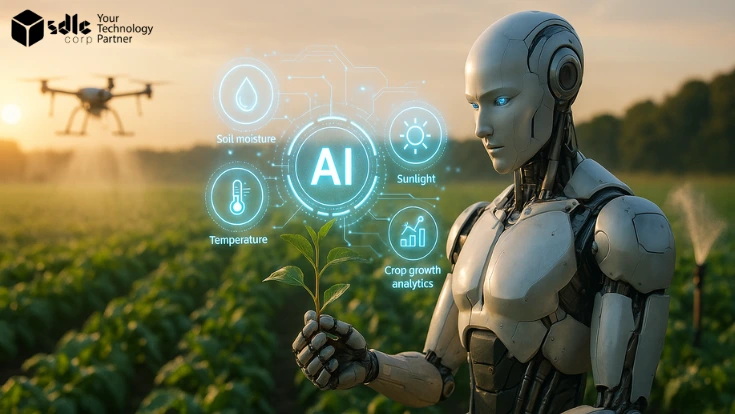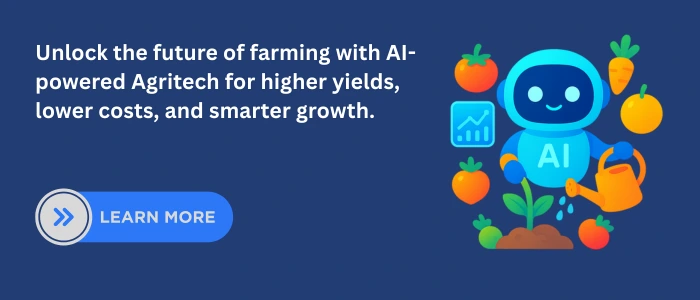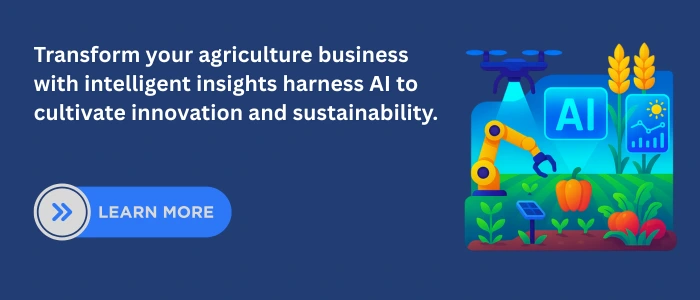Introduction
Feeding the world is becoming increasingly complex as the population grows, food demand rises, and natural resources shrink. Climate change adds further pressure, disrupting yields and threatening global food security. Traditional farming methods cannot meet these challenges effectively, which is why AI for Agritech is emerging as a transformative solution. By combining artificial intelligence with modern farming, it enables smarter, faster, and more sustainable decisions. Across the globe, AI for Agritech is already redefining how farmers manage crops, livestock, and resources.
At its foundation, AI for Agritech integrates computer vision, predictive analytics, and robotics to create data-driven ecosystems. These technologies empower farmers to monitor soil health, forecast yields, detect diseases, and automate harvesting, ensuring both efficiency and resilience. With the global population projected to reach 8.5 billion by 2030 and food demand expected to rise 50% by 2050, adopting AI Development for Agritech solutions is essential for building a sustainable, future-ready farming model.
1.AI for Agritech – Revolutionizing the Future of Farming
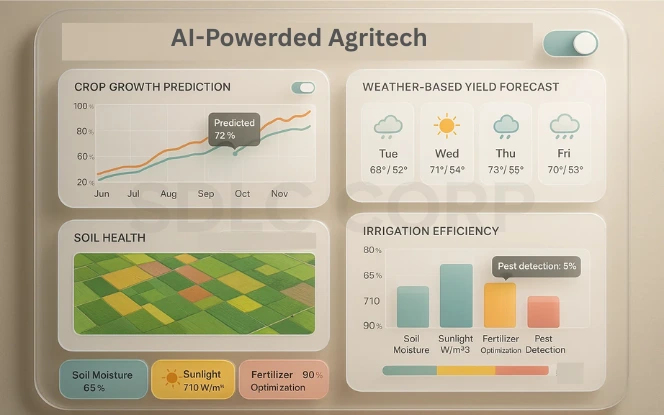
The global population is rising, and with it, food demand continues to grow at an unprecedented pace. Traditional farming practices, constrained by limited land, water scarcity, and labor shortages, can no longer meet these requirements. Consequently, AI for Agritech is emerging as a transformative approach to ensure efficient and sustainable farming.
AI for Agritech refers to the integration of artificial intelligence into agriculture. It combines data-driven insights, automation, and smart technologies to improve productivity and reduce environmental strain. The importance of this shift lies in its ability to bridge the gap between increasing global food demand and limited natural resources.
Explore More : AI for Agriculture
Core Technologies Powering AI for Agritech
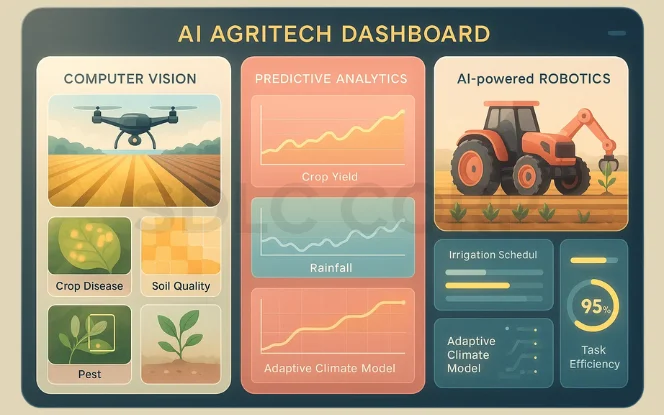
- Computer Vision: Enables early disease detection, soil analysis, and pest recognition.
- Predictive Analytics: Provides accurate yield forecasts, irrigation planning, and climate adaptability.
- AI-powered Robotics: Automates tasks such as planting, weeding, and harvesting to reduce manual labor.
Globally, this matters more than ever. Climate change, shrinking arable land, and disrupted supply chains challenge food security. By adopting AI for Agritech, nations can build resilience, protect resources, and create future-ready farming systems that feed billions sustainably.
2. Why AI for Agritech is Critical Today
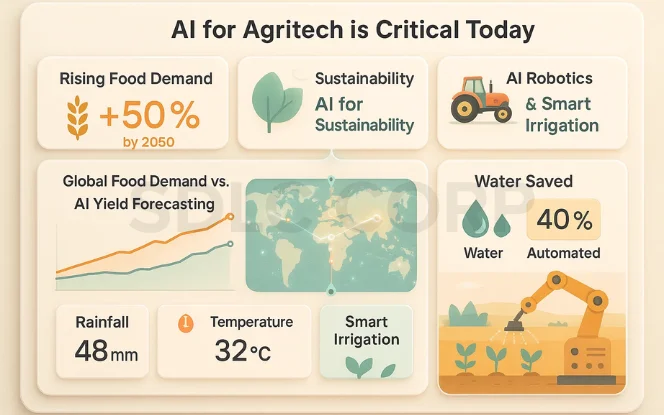
Global agriculture stands at a turning point. The demand for food is rising rapidly, while resources remain finite and climate challenges grow more severe. In this context, AI for Agritech is not simply a technological option but a necessity for sustaining future food systems.
Rising Food Demand
By 2050, the world must produce nearly 50% more food to meet population growth. Traditional farming techniques cannot scale efficiently under these pressures.
Challenge: Growing food demand.
AI for Agritech Solution: Data-driven crop management, predictive yield forecasting, and supply chain optimization close the gap between demand and production capacity.
Climate Variability & Sustainability
Climate change introduces uncertainty with unpredictable rainfall, rising temperatures, and shifting seasons. These factors disrupt planting cycles and yield stability.
- Challenge: Climate unpredictability.
- AI for Agritech Solution:
- Real-time weather analysis empowers farmers to adjust practices dynamically.
- Smart algorithms optimize water, fertilizer, and energy use.
- Sustainable practices ensure productivity while reducing the environmental footprint.
- Real-time weather analysis empowers farmers to adjust practices dynamically.
Resource Scarcity & Labor Shortages
Farmland and freshwater are increasingly scarce, while many regions also face acute labor shortages. Manual farming cannot maintain efficiency under these conditions.
- Challenge: Scarcity of natural resources.
- AI for Agritech Solution:
- Robotics automate labor-intensive processes such as weeding, planting, and harvesting.
- Smart irrigation systems powered by AI conserve water and ensure precise allocation.
- Robotics automate labor-intensive processes such as weeding, planting, and harvesting.
Challenges vs AI Solutions in Agritech
- Rising food demand → AI-driven predictive analytics for yield forecasting.
- Unpredictable climate → AI-based weather modeling and adaptive farming strategies.
- Soil and water scarcity → AI precision irrigation and soil health monitoring.
- Labor shortages → AI robotics for autonomous planting and harvesting.
- Supply chain inefficiencies → AI-enabled logistics and distribution optimization.
Through these applications, AI for Agritech addresses critical agricultural pain points with scalable and intelligent solutions. The combination of predictive models, computer vision, and robotics ensures that farming remains resilient in the face of global challenges. Consequently, agriculture transitions into a sustainable, data-powered ecosystem capable of meeting tomorrow’s food requirements.
3.Computer Vision in AI for Agritech
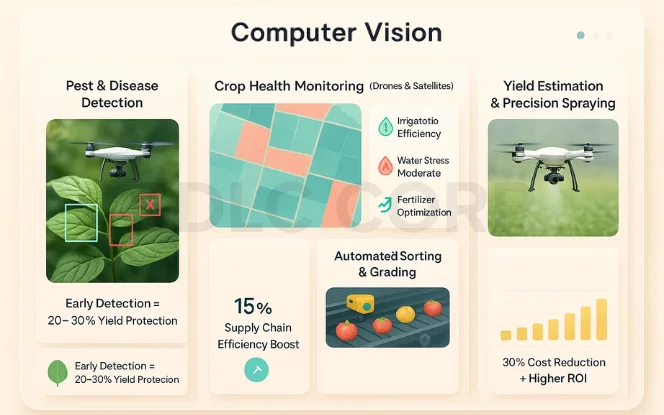
Among the many innovations in artificial intelligence, computer vision stands out as one of the most impactful. Within AI for Agritech, computer vision enables farmers to capture and process visual data from fields, drones, and satellites. These insights support precise decision-making, improve efficiency, and minimize losses. By combining imagery with machine learning, agriculture becomes smarter, more accurate, and more sustainable.
Early Pest & Disease Detection
Crop damage from pests and diseases accounts for major yield losses worldwide. With AI for Agritech, farmers gain a proactive approach through computer vision.
- AI models analyze plant images to detect early anomalies.
- Real-time alerts empower farmers to take preventive measures.
Protected yields and reduced pesticide use improve overall productivity.
Crop Health Monitoring with Drones & Satellites
Drones and satellites equipped with multispectral and hyperspectral sensors scan large fields rapidly. This creates a powerful extension of AI for Agritech, where computer vision transforms imagery into actionable insights.
- Detects water stress, nutrient deficiencies, and soil imbalances.
- Helps farmers optimize irrigation, fertilizer, and pesticide usage.
- Improves both sustainability and profitability with precision farming.
Automated Quality Control & Sorting
Post-harvest operations are just as critical as crop production. Computer vision in AI for Agritech automates quality checks with high accuracy.
- Sorting and grading of fruits, vegetables, and grains becomes automated.
- Systems evaluate size, color, and texture more accurately than manual inspection.
- Results: consistency in supply chains, reduced errors, and lower labor dependency.
Yield Estimation & Precision Spraying
Traditionally, yield forecasting has been guesswork. With AI for Agritech, computer vision transforms this process into a precise science.
- Vision-based models count fruits, estimate biomass, and predict yields.
- Smart sprayers equipped with AI cameras deliver fertilizers and pesticides only where required.
- Benefits include cost reduction, minimized waste, and higher returns on investment.
Table: Computer Vision Applications in AI for Agritech
| Application | Benefits | Impact on Farming |
|---|---|---|
| Pest & Disease Detection | Real-time alerts, early intervention | 20–30% yield protection |
| Drone & Satellite Crop Monitoring | Optimized irrigation and fertilization | 25% input savings |
| Automated Sorting & Grading | Accurate quality control and reduced labor costs | 15% efficiency boost in supply chain |
| Yield Estimation & Precision Spraying | Accurate forecasting, reduced chemical use | 30% cost reduction + higher ROI |
By integrating computer vision into farming, AI for Agritech delivers solutions that extend from the field to the market. From early detection to automated sorting, each application reduces inefficiency and creates measurable value. This combination of accuracy, scalability, and cost-effectiveness ensures that agriculture is future-ready and resilient.
Learn More : Generative AI for Agritech
4. Predictive Analytics and Big Data in AI for Agritech
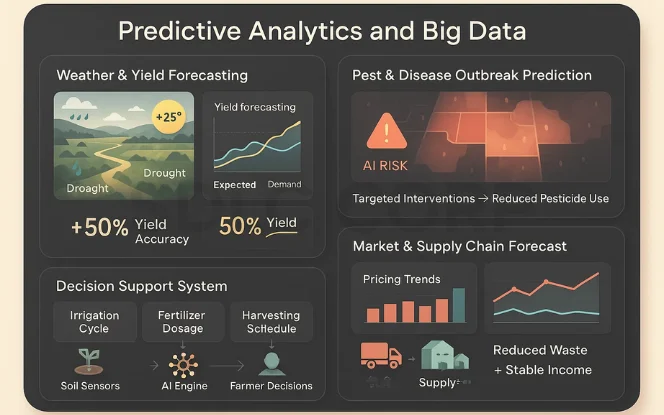
The ability to predict outcomes with accuracy is becoming essential in agriculture. Through predictive analytics and big data, AI for Agritech converts raw information into actionable insights. As a result, farmers improve yields, manage risks, and adapt to changing conditions effectively.
Weather & Yield Forecasting
Weather variability is one of the most significant threats to farming. Predictive models in AI for Agritech analyze satellite data, soil sensors, and historical climate patterns to forecast rainfall, droughts, and temperature shifts.
- Farmers adjust planting schedules and irrigation systems proactively.
- Yield forecasting algorithms estimate production volumes with higher precision.
- Resources are aligned with demand, reducing both waste and shortages.
Pest & Disease Outbreak Predictions
Uncontrolled pest and disease outbreaks can devastate harvests. Within AI for Agritech, predictive analytics combines climate data, crop imagery, and past infestation records to identify outbreak risks.
- Farmers receive early warnings to take preventive action.
- Pesticide use drops significantly due to targeted interventions.
- Crops remain healthier and more resilient throughout the season.
Decision Support Systems
Farming decisions often require balancing multiple variables at once. Decision support systems powered by AI for Agritech integrate weather data, soil metrics, and market trends into real-time recommendations.
- Farmers gain guidance on irrigation cycles and fertilizer application.
- Smart systems optimize harvesting schedules for maximum efficiency.
- Evidence-based decision-making reduces risks and improves profitability.
Market & Supply Chain Forecasts
Profitability in farming depends not only on yields but also on how products reach markets. Predictive analytics in AI for Agritech models demand, logistics performance, and pricing trends.
- Farmers identify the best selling times and market routes.
- Transparency strengthens supply chains and reduces waste.
- Income stability increases as farmers adapt to market fluctuations.
Predictive Models and Benefits
- Climate forecasting models → Adapt planting cycles to weather shifts.
- Yield prediction algorithms → Plan resources with higher accuracy.
- Outbreak simulations → Prevent pest and disease damage.
- Market forecasting tools → Optimize pricing and distribution.
- Supply chain analytics → Minimize post-harvest losses.
Predictive analytics ensures that AI for Agritech does more than automate tasks. It empowers farmers with foresight, reduces uncertainty, and optimizes sustainability. With data-driven intelligence, agriculture moves from reactive practices to proactive systems that secure food for the future.
5. Benefits of AI for Agritech
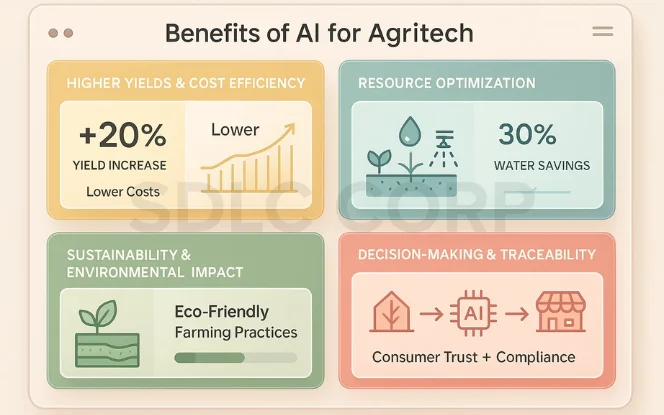
The adoption of AI for Agritech delivers measurable improvements across productivity, efficiency, and sustainability. Farmers not only enhance output but also reduce risks while ensuring smarter use of natural resources. These benefits make artificial intelligence a cornerstone of future-ready farming systems.
Higher Yields & Cost Efficiency
With predictive analytics, robotics, and computer vision, AI for Agritech helps farmers maximize crop yields while minimizing input costs. Automated monitoring reduces wastage, while precise interventions lower operational expenses.
- Increased yields through real-time monitoring.
- Lower operational costs from automation.
- Improved profitability and enhanced food security.
Resource Optimization
Efficient use of water, fertilizers, and pesticides is critical in modern farming. AI for Agritech leverages smart irrigation, soil monitoring, and precision spraying to optimize inputs.
- Conserves water and reduces fertilizer overuse.
- Minimizes pesticide application.
- Reduces environmental strain while boosting efficiency.
Sustainability & Environmental Impact
By cutting waste and limiting chemical usage, AI for Agritech supports sustainable agriculture.
- Reduces emissions and improves soil health.
- Encourages eco-friendly farming practices.
- Lowers overall carbon footprint for long-term resilience.
Improved Decision-Making & Traceability
Decision-making becomes faster and more data-driven when powered by AI for Agritech. Blockchain integration enhances supply chain transparency and ensures compliance with global food standards.
- Real-time insights improve decision quality.
- Traceability builds consumer trust.
- Compliance with international food safety regulations.
6. Challenges of Implementing AI for Agritech
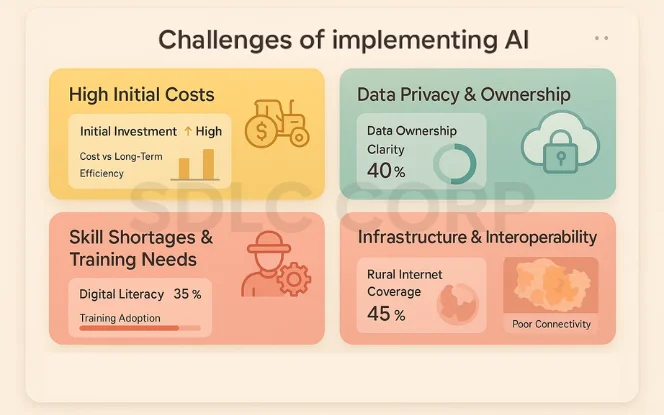
While the potential is immense, implementing AI for Agritech comes with significant challenges. These barriers limit adoption, particularly in regions where infrastructure and resources remain underdeveloped.
High Initial Costs
Advanced AI-powered equipment, robotics, and computer vision systems require substantial upfront investment.
- Small and medium-scale farmers often find these costs prohibitive.
- Initial affordability remains a barrier despite long-term efficiency gains.
- Scaling AI for Agritech solutions will require subsidies, financing, and collaborative models.
Data Privacy & Ownership
Agriculture generates massive volumes of data through sensors, drones, and connected devices. However, data governance remains a critical challenge.
- Farmers often lack clarity on who owns and controls generated data.
- Concerns about storage, access, and misuse limit confidence.
- Effective AI for Agritech adoption requires transparent frameworks and secure policies.
Skill Shortages & Training Needs
The effective use of AI for Agritech systems requires specialized digital and technical skills. Many farming communities, especially in rural areas, lack adequate exposure to such technologies.
- Insufficient training in digital literacy slows adoption.
- Without structured education, technology uptake remains uneven.
- Training programs and AI-driven advisory services can help bridge this gap.
Infrastructure & Interoperability Challenges
Infrastructure limitations remain one of the biggest barriers to scaling AI for Agritech.
- Poor internet connectivity and unstable electricity supply hinder adoption.
- Lack of interoperability between traditional farming equipment and AI platforms reduces efficiency.
- Investment in rural digital infrastructure is essential for long-term success.
7. Future Outlook of AI for Agritech
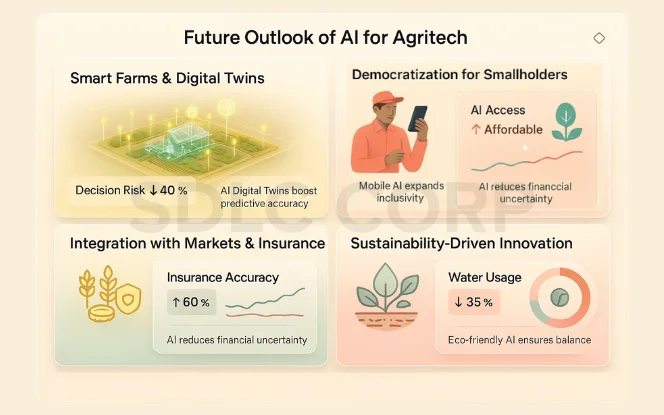
The future of agriculture will be defined by intelligent systems and sustainable innovation. As technology advances, AI for Agritech will evolve from niche adoption to mainstream implementation, enabling smarter, more resilient, and more inclusive farming practices worldwide.
Check Out : Generative AI for Agriculture
Smart Farms & Digital Twins
Smart farms powered by IoT sensors, robotics, and predictive analytics are expected to become increasingly common. Through AI for Agritech, digital twins of farms replicate real conditions in virtual models, allowing farmers to:
- Test strategies before field application.
- Predict outcomes with greater accuracy.
- Reduce risks while enhancing decision-making speed.
This innovation ensures higher efficiency and supports sustainable farming.
Democratization of AI for Smallholders
Currently, most AI for Agritech benefits are concentrated among large-scale farms. The next phase will emphasize inclusivity, giving smallholder farmers access to intelligent solutions.
- Affordable AI tools and mobile-based advisory platforms expand accessibility.
- Government initiatives and subsidies support digital adoption.
- Small-scale producers gain competitive advantages through advanced insights.
Integration with Markets & Insurance
Agricultural success depends on more than production; stable markets and financial protection are essential. Predictive analytics in AI for Agritech will directly integrate with markets and insurance platforms.
- Farmers receive accurate market forecasts for better pricing decisions.
- AI systems reduce financial uncertainty by improving crop insurance accuracy.
- Stronger risk management enhances farmer resilience.
Sustainability-Driven Innovation
Sustainability will remain central to the evolution of AI for Agritech. By focusing on eco-friendly solutions, future innovations will ensure productivity and environmental balance.
- Reduces water consumption through smart irrigation.
- Lowers emissions by minimizing chemical usage.
- Enhances soil health for long-term agricultural resilience.
8. Global Case Studies of AI for Agritech
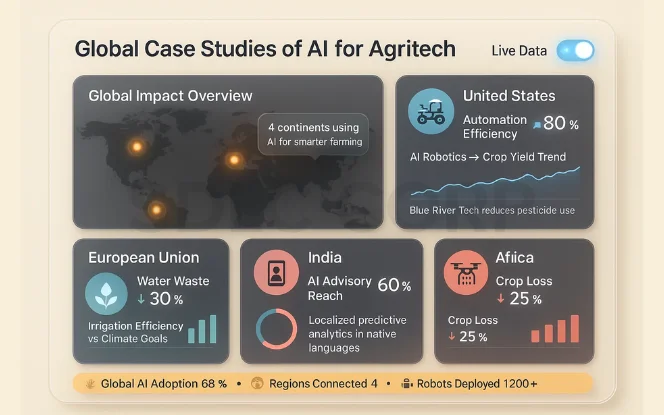
The impact of AI for Agritech can already be seen worldwide, with governments, startups, and agribusinesses driving adoption. Each region demonstrates unique applications tailored to local challenges and opportunities.
United States
In the United States, large agribusinesses rely heavily on automation and robotics.
- Computer vision and robotics enable automated harvesting and precision spraying.
- Startups such as Blue River Technology deploy AI-powered tools that reduce pesticide use and increase yields.
- Large-scale farms integrate AI for Agritech into logistics and supply chain efficiency.
European Union
Across the European Union, sustainability targets fuel innovation.
- Governments support AI for Agritech adoption through policy-driven projects.
- Smart irrigation systems and crop monitoring platforms reduce water waste.
- Predictive analytics aligns farming practices with climate-neutral goals.
India
In India, the democratization of AI has transformed farming for smallholder farmers.
- Mobile-based advisory platforms deliver real-time weather, soil, and market insights.
- Startups leverage AI for Agritech to provide predictive analytics in local languages.
- Farmers access affordable, localized solutions that bridge digital divides.
Africa
Within Africa, AI for Agritech initiatives focus on food security and resilience.
- Drone-based crop surveys support large-scale monitoring.
- AI-driven pest control systems help protect harvests against climate variability.
- Governments and NGOs collaborate to make AI accessible to small-scale farmers.
Conclusion
AI for Agritech is transforming farming through computer vision, predictive analytics, and robotics, enabling higher yields, smarter resource use, and resilient food supply chains. But technology must work alongside farmer expertise and traditional practices. With governments, businesses, and farmers investing in scalable solutions, agriculture can achieve sustainability and global food security. Ultimately, AI for Agritech is not just a trend but a necessity for the future of farming. Explore our AI Development Solution to see how innovation can reshape agriculture for the future.
FAQs
Q1. What is AI for Agritech?
AI for Agritech refers to the application of artificial intelligence technologies such as computer vision, predictive analytics, and robotics to optimize agricultural processes. It improves crop yields, reduces resource waste, and enhances sustainability.
Q2. How does AI for Agritech improve crop yields?
AI for Agritech improves crop yields through early pest and disease detection, predictive yield forecasting, and precision resource management. Farmers use data-driven insights to make more accurate decisions and maximize productivity.
Q3. What are the benefits of AI for Agritech in sustainability?
The primary benefits include reduced pesticide and water usage, lower carbon emissions, and improved soil health. AI for Agritech supports sustainable farming while balancing environmental goals with food production needs.
Q4. What challenges limit the adoption of AI for Agritech?
Key challenges include high initial investment, lack of infrastructure in rural areas, data privacy issues, and skill shortages. Overcoming these requires government support, affordable solutions, and farmer training programs.
Q5. What is the future of AI for Agritech?
The future will see smart farms, digital twins, AI-powered robotics, and advanced supply chain forecasting. As adoption expands, AI for Agritech will drive global food security and climate-smart farming practices.

